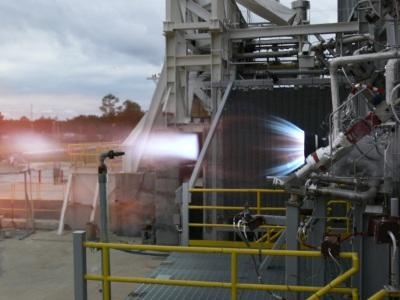Wed, Oct 17, 2012
Will Power Reusable Booster System To Lift Company's Biconic Space Vehicle
NASA's Commercial Crew Program (CCP) partner Blue Origin has successfully fired the thrust chamber assembly for its new 100,000 pound thrust BE-3 liquid oxygen, liquid hydrogen rocket engine. As part of Blue's Reusable Booster System (RBS), the engines are designed eventually to launch the biconic-shaped Space Vehicle the company is developing.

The test was part of Blue Origin's work supporting its funded Space Act Agreement with NASA during Commercial Crew Development Round 2 (CCDev2). CCDev2 continues to bring spacecraft and launch vehicle designs forward to develop a U.S. commercial crew space transportation capability that ultimately could become available for the government and other customers. "Blue Origin continues to be extremely innovative as it develops a crew-capable vehicle for suborbital and orbital flights," said Ed Mango, CCP manager. "We're thrilled the company's engine test fire was met with success."
The test took place early this month on the E-1 test stand at NASA's Stennis Space Center near Bay St. Louis, Miss. Blue Origin engineers successfully completed the test by powering the thrust chamber to its full power level. "We are very excited to have demonstrated a new class of high-performance hydrogen engines," said Rob Meyerson, president and program manager of Blue Origin. "Access to the Stennis test facility and its talented operations team was instrumental in conducting full-power testing of this new thrust chamber."
As part of CCDev2, Blue Origin also completed a system requirements review of its spacecraft. During the review, engineers and technical experts representing NASA, the Federal Aviation Administration and the company assessed the spacecraft's ability to meet safety and mission requirements to low-Earth orbit. That review also included results from more than 100 wind tunnel tests of the vehicle's aerodynamic design, stability during flight and cross-range maneuverability.
(NASA image of Blue Origin rocket motor test)
More News
DETRESFA (Distress Phrase) The code word used to designate an emergency phase wherein there is reasonable certainty that an aircraft and its occupants are threatened by grave and i>[...]
"General aviation is at the forefront of developing and introducing innovative technologies that will transform the entire aviation industry..." Source: Kyle Martin, Vice President>[...]
Direct Straight line flight between two navigational aids, fixes, points, or any combination thereof. When used by pilots in describing off-airway routes, points defining direct ro>[...]
Aero Linx: Women in Corporate Aviation Women in Corporate Aviation support individuals seeking career advancement and professional development in the business aviation industry. Me>[...]
“We would like to thank the many volunteers that help throughout the year to pull off the event, as well as the several reviewers, judges, and SURVICE staff that provide team>[...]
 ANN's Daily Aero-Term (04.26.24): DETRESFA (Distress Phrase)
ANN's Daily Aero-Term (04.26.24): DETRESFA (Distress Phrase) Aero-News: Quote of the Day (04.26.24)
Aero-News: Quote of the Day (04.26.24) ANN's Daily Aero-Term (04.27.24): Direct
ANN's Daily Aero-Term (04.27.24): Direct ANN's Daily Aero-Linx (04.27.24)
ANN's Daily Aero-Linx (04.27.24) Aero-News: Quote of the Day (04.27.24)
Aero-News: Quote of the Day (04.27.24)



